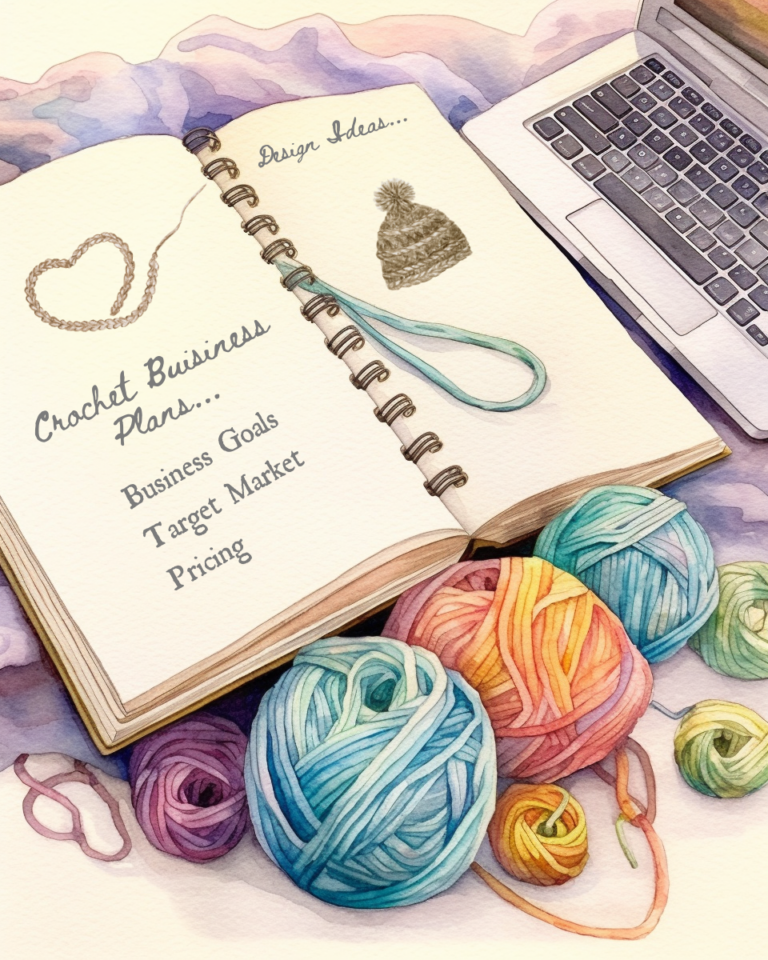Starting a Craft Business: Simple Steps for Success
Starting a craft business can be a fulfilling and exciting venture. You already possess artistic flair, and now you have the opportunity to showcase your creativity and make a living out of your passion. With countless crafting niches to choose from, you can transform your hobby into a thriving business that showcases your unique talents.

Before diving into your own craft business, it’s important to identify your niche and understand your target audience. A well-researched business plan helps set the stage for a successful venture.
Take the time to understand the legal, logistical, and branding aspects of your business while maintaining a friendly and approachable demeanor towards your customers.
Building your online presence is crucial in this digital age, and marketing your crafts effectively will help your business gain traction. Remember, hard work, dedication, and superior craftsmanship can propel your craft business towards success.
Understanding Craft Business Fundamentals
Starting your own craft business can be a great way to turn your passion into profit. It allows you to become your own boss and puts you in control of your financial future. However, it’s essential to understand the fundamentals of running a successful craft business before diving in headfirst.
First and foremost, identify your ideal customer. This will help you target your marketing efforts effectively and connect with the right audience. Think about who will appreciate your unique creations and be willing to pay for them.
Participating in craft fairs can be another crucial aspect of growing your business. These events provide the perfect opportunity to showcase your products and network with other like-minded individuals. While attending fairs, you might also discover niche markets that can benefit from your craft.
Hard work and dedication are necessary for any business venture, and starting a craft business is no different. Be prepared to invest time, energy, and resources into developing your skills, refining your products, and expanding your customer base.
Building a strong online presence is also an essential part of running a successful craft business. Start by setting up a user-friendly website or online shop to showcase your creations and make it easy for customers to purchase them.
Additionally, leverage social media channels to connect with fans and potential clients, promoting your products and staying engaged with your audience.
Taking the first step to start your own craft business can feel daunting, but with the right mindset and determination, it can be an exciting and rewarding journey. Understanding the fundamentals is an important part of creating a solid foundation for your business, and with dedication and perseverance, you’ll be able to turn your passion into a successful livelihood.
Choosing Your Craft Business Niche
Good news, you’re in the right place to start your journey towards launching a successful craft business! Finding your niche market will be one of the crucial initial steps to ensure your handmade crafts have the desired impact. So let’s dive in and help you choose the perfect craft niche for your business.
First things first, identify what type of product you have a passion for creating. By focusing on your interests and talents, you can produce high-quality, unique handmade crafts, which will stand out in your craft store and attract customers. Remember, a niche market is a focused segment of a larger market, so choosing a specialized product will increase your chances of success.
Next, get to know your target audience better. Pay attention to the needs, preferences, and demographics of your potential customers. Analyze existing craft stores and how they cater to their audience. Learn from them, but aim to differentiate your products by adding a touch of your style or offering something that fills a gap in the market.
After narrowing down your product ideas, it’s time to do a bit of research. Monitor market trends and understand the demand for different types of crafts. Explore various online and offline communities, forums, and social media platforms to see how your potential audience is engaged with their favorite crafts. Use these insights to refine your niche and make informed decisions.
Finally, once you have chosen your niche, make sure to be consistent and true to your brand identity. This will not only help build customer loyalty but also ensure that your products stand out amidst the sea of handmade crafts available in the market.
By following these steps, you are setting yourself up for success in carving out your very own niche in the craft business world. So go on, transform your passion into a thriving business, and spread the joy of your unique creations. Happy crafting!
Craft Business Structures
When you’re starting your craft business, one of the first decisions you’ll need to make is the legal structure of your business, or the business entity. As a small business owner, you have several options to choose from, mainly sole proprietorship, limited liability company (LLC), and partnerships.
A sole proprietorship is the simplest business structure for small businesses. As a sole proprietor, you’re considered the same legal entity as your business, and you have full control over it. However, this also means you take on full liability for any debts or legal issues your business may face. It’s important to remember that since you and your business are considered the same entity, you’ll report the business’s profits and losses on your personal tax return.
Another popular option for craft businesses is a limited liability company (LLC). This structure provides you with limited personal liability for your business’s debts and legal issues. This means your personal assets, like your house or car, would be protected if your business faces any financial or legal issues. Keep in mind that an LLC typically requires more paperwork and fees compared to a sole proprietorship. The tax structure of an LLC may vary; it can either be treated as a sole proprietorship, partnership, or corporation for tax purposes.
Choosing the right business structure for your craft business depends on your personal preferences, financial situation, and long-term business goals. As you consider your options, think about the level of personal risk you’re willing to accept and the responsibilities you want to take on as the business owner.
As you decide on the structure for your craft business, it’s also important to choose a business name. This should be unique, memorable, and reflect your brand and the type of products you sell. Make sure to research the name to ensure it’s not already in use and register it with the appropriate state and local agencies.
In conclusion, selecting the best business structure for your craft business is an important decision. Be sure to consider the implications of each structure, your desired level of risk, and your long-term goals when making your choice. And don’t forget to give your business a unique and memorable name to help it stand out and connect with your target audience.
Market Research for a Successful Craft Business
Understanding your potential customers is essential when starting a crafting business. Conducting market research will help you determine who your target audience is and develop a loyal customer base. This involves gaining insights into what your customers need, want, and love, as well as understanding the competition in your chosen niche.
Attend craft shows to observe the sales and traffic patterns of various sellers. You’ll get a better understanding of popular crafting styles and products.
Additionally, examine online marketplaces like Etsy and Handmade at Amazon to identify the latest trends in the crafting industry. Take note of existing product categories with high demand but relatively low numbers of sellers offering similar items.
When you’ve pinpointed your target market, spend time developing important personal connections. Engage with them through social media platforms or build an email list to gather feedback and insights on their preferences. Understanding the likes and dislikes of your target audience will help you create unique, in-demand products for your craft business.
Thorough market research enables you to identify the ideal customers for your crafting business, recognize gaps in the market, and distinguish your brand from others selling similar products. The insights gained from research will ultimately contribute to the foundation of a successful craft business.
Creating Your Online Craft Presence
Starting your online craft business is an exciting venture. To establish a strong presence, you’ll need to create an online store and utilize social media platforms effectively.
First things first, decide whether you’d like to have your own website or sell your crafts through an online marketplace like Etsy.
If you choose to create your own website, you’ll need to select a domain name that reflects your brand and appeals to your target audience. Make sure it’s easy to remember and unique.
Once you have your domain name, set up your online shop by uploading product images, descriptions, and prices. Make sure your online store is user-friendly and mobile-responsive, as most customers will likely browse using their smartphones.
Social media accounts play a crucial role in promoting your craft business. Set up accounts on platforms such as Facebook, Instagram, Pinterest, and Twitter.
Start by creating a Facebook page for your business, where you can showcase your products, announce sales or promotions, and interact with your customers.
To further engage with your target audience, share high-quality images and videos of your crafts on Instagram and Pinterest. These visual platforms are the best places to display your creativity and attract potential customers.
Tailor your content for each social media platform and remember to post consistently. You might find it helpful to create a content calendar to help you plan what to post and when. Additionally, don’t forget to use relevant hashtags and engage with your followers to build a loyal customer base.
While it’s important to use social media for your business, please don’t try to be all the places all the time. I tried that and totally burned out. Instead, try focusing on growing the platform that you enjoy the most and is where your target audience hangs out.
Creating an online presence for your craft business involves setting up an online store, either on your own website or an online marketplace, and utilizing social media platforms to promote your products. With a friendly tone and a consistent approach, you’ll be well on your way to crafting a successful online presence.
Setting Up a Pricing Strategy and Profitability
When starting your craft business, it’s essential to create a solid pricing strategy to ensure profitability. This means you’ll need to find the right balance between covering your costs, achieving your desired profit margins, and offering prices that will attract customers. Let’s dive into how to do this.
First, you’ll want to calculate the cost of producing your crafts, which includes material costs, labor, and overhead expenses (such as rent, utilities, and marketing). To determine your wholesale price, add your desired profit margin to the cost of creating your items.
A common profit margin in the craft industry is around 50% of the cost, but this can vary depending on your niche and market demand. As you set your retail price, remember that it should be at least twice your wholesale price to account for any markup charged by retailers carrying your products.
To help illustrate this pricing strategy, let’s imagine you have a side project making handmade candles:
- Material costs (wax, wick, scent, etc.): $5
- Labor costs (time spent crafting): $10
- Overhead expenses (marketing, rent, etc.): $2
Total costs: $17
Now, add your desired profit margin (let’s go with 50%): Total cost ($17) + 50% profit margin ($8.50) = Wholesale price of $25.50
Finally, set your retail price by doubling your wholesale price: Wholesale price ($25.50) x 2 = Retail price of $51
With formulas like these in place, you can adjust and experiment as needed. Just be sure never to sell yourself short; you deserve to make a decent profit from your hard work. Additionally, keep an eye on your competitors and market trends to ensure your prices remain competitive and attractive to customers.
By following these pricing strategy guidelines, you’ll be well on your way to a profitable craft business that brings both enjoyment and profit. Good luck on your crafting journey!
Learn more about how to price handmade items here
Craft Business Legalities and Licensing
Starting a craft business can be an exciting endeavor, but it’s important to make sure you’re going about it the right way. In this section, we’ll discuss the legalities and licensing needed for your new business, so you can put your best foot forward.
Firstly, you’ll need to choose a business entity for your craft enterprise. Many small artisans and crafters opt for a sole proprietorship because it’s the simplest option. Think about what works best for your situation and consult with a professional if needed.
With your business type selected, it’s time to choose a name for your craft business, also known as a DBA or “doing business as.” Make sure the name is unique and represents your craft well. Once you’ve decided on a name, you’ll need to file it with your county.
Now that the foundation is laid, it’s essential to create a formal business plan. A well-crafted business plan will outline your goals, target market, competition, and financial projections. This document will help guide you through the early stages of your craft business and prove invaluable in securing loans or investors.
Next, look into the licenses and permits required at the local, state, and federal levels. Different locations may have different requirements, so it’s crucial to research what applies to you.
Often, you’ll need a business license to sell your crafts, especially at craft fairs and events. Additionally, sales and use tax permits may be necessary if you plan to sell your items on a more extensive scale, but it varies by state.
As you move forward with your craft business, always keep records of your sales, expenses, and tax obligations. Staying organized will make managing your business easier and ensure you’re compliant with local laws and regulations.
By following these steps, you’ll be well on your way to establishing a legal and successful craft business. Be sure to check the laws of the state you live in for more information about legalities.
Marketing your Craft Business
Starting on the right foot with marketing your craft business is essential to attract customers and showcase your handmade creations. So, let’s go through some of the important things to consider when developing your marketing plan.
First, business cards are always a good idea. Create eye-catching, memorable cards that showcase your unique style and include your contact information. This will help customers remember your brand and reach out to you when they’re looking for something special. Don’t forget to include your email address on the card, as today’s customers often communicate through email.
Creating a solid craft business plan will go a long way in keeping you organized and focused on your goals. This includes everything from identifying your target market to estimating your expenses and potential revenue. Give yourself a timeline to ensure you’re allocating enough time to address all aspects of the plan.
Effective marketing hinges on creating the right content that resonates with your target audience, and this is the final step before implementing your marketing plan. Craft engaging, visually appealing content that showcases your handmade business in the best light possible. Social media platforms, blog posts, and email marketing campaigns are all great ways to share your work.
Here are a few tips to keep in mind as you market your craft business:
- Be consistent in your messaging and branding – This allows customers to recognize your brand across different platforms.
- Engage with your audience by responding to comments and questions and sharing user-generated content.
- Promote in-person events (if applicable) to connect with customers face-to-face.
- Experiment with different marketing approaches to determine what works best for your specific handmade business.
Remember, starting a craft business takes dedication, creativity, and a willingness to adapt along the journey. By investing your time and effort into promoting your brand, you’ll see your hard work pay off as more customers discover and fall in love with your unique creations. Good luck, and happy marketing!
Expanding Beyond Online: Craft Shows and Fairs
As a small business owner looking to make your creative business a successful and profitable full-time endeavor, it’s important to consider expanding beyond your online craft presence. Craft shows and fairs offer a fantastic opportunity for you to showcase your personal assets, meet new customers and network with fellow artisans.
Attending craft fairs will allow you to make personal connections that can greatly benefit your business in the long run. Engaging face-to-face with potential customers gives you the chance to explain the uniqueness of your products, and possibly even garner feedback on how to improve them. Moreover, participating in such events can help you gain valuable insights into industry trends, pricing, and buying patterns.
While it may seem daunting to allocate time and resources to set up at craft shows and fairs, doing so can be important for the growth of your business. Be sure to plan your event schedule strategically, prioritizing those with a high likelihood of drawing your target audience.
In order to make the most of these events, it’s crucial to present your products in an attractive and organized manner. Utilize eye-catching, well-designed displays to grab the attention of passersby and convey your brand’s identity. Your booth should reflect your unique style and present a cohesive image to potential customers.
Lastly, as you participate in craft fairs, remember to set specific goals for each event. These goals could include generating a certain number of sales, capturing a specific number of email addresses for your mailing list, or simply making meaningful connections with fellow artists and potential customers.
Embracing craft shows and fairs as part of your business strategy will not only help in building a successful online craft business but also lay the foundation for a long-lasting, profitable, and sustainable creative endeavor.
Turning Your Crafting Hobby into a Business
Congratulations on taking the first steps to turning your crafting hobby into a successful business! As a new craft business owner, there are a few important tasks you need to complete in order to have a solid foundation for your venture. In this section, we’ll discuss how to transform your passion for creating beautiful things into a thriving home craft business.
First, let’s establish the main difference between a hobby and a business: profit. To make a profit in your own business, you need to consider factors like pricing, inventory management, and marketing. Let’s dive into these topics!
Pricing: When setting the prices for your craft products, consider the cost of materials, labor, overhead expenses, and desired profit margin. This is incredibly important in order to ensure that you’re not only covering your costs but also earning a fair income for your time and creativity.
Inventory Management: Keeping track of your inventory is essential when running your own business. Make a habit of regularly updating your inventory records and organizing your supplies. This will allow you to fulfill orders efficiently and proactively replenish stock before running out.
Marketing: A good way to attract customers and establish your unique brand is by taking good photos of your craft products and showcasing them on social media or your website. Share your creative process, your inspiration, and the story behind your creations to connect with potential customers on a personal level.
Running a home craft business means having the freedom to manage your own schedule, but it also comes with the responsibility of handling various tasks. Here are a few additional items to consider when starting your new craft business:
- Choose a business structure (e.g., sole proprietorship, LLC)
- Obtain any necessary licenses or permits
- Set up a record-keeping system for income, expenses, and taxes
- Create a branding strategy that reflects your unique style and products.
By taking the time to plan and properly establish your new craft business, you’ll be well on your way to turning your crafting hobby into a successful and fulfilling career. Remember to stay true to your vision and continue creating beautiful things that bring joy to both you and your customers. Good luck on your new and exciting journey!
Different Types of Craft Businesses
Starting a craft business allows you to express your creativity and turn your hobby into a source of income. As you embark on this exciting journey, it’s important to identify the type of craft business that best suits your skills and interests. Here are some different types of craft businesses to consider:
1. Handmade jewelry: If you have a knack for designing and creating unique, eye-catching jewelry pieces, starting a handmade jewelry business is a great option. From earrings to necklaces, you can create your own distinct style and cater to various tastes and preferences.
2. Personalized gifts: Personalized gifts, such as custom mugs, T-shirts, and home decor items, are always in demand. By offering a wide range of customizable products, you can create a one-stop shop for customers seeking thoughtful, unique presents.
3. Paper goods: Designing and producing paper goods like greeting cards, stationery, and invitations can be both fun and lucrative. If you’re skilled in calligraphy or graphic design, this type of craft business might be perfect for you.
4. Sewing and textiles: If your talents lie in sewing, embroidery, or knitting, consider starting a business focused on textiles. You can create handmade clothing, accessories, or home goods that appeal to a wide range of customers. (This is my area!)
5. Bath and body products: Making and selling bath bombs, soaps, and other body products can be both enjoyable and profitable. With a focus on unique scents, organic ingredients, and eye-catching packaging, you can tap into the growing market for self-care products.
6. Art and illustration: For those with a passion for drawing, painting, or digital art, starting an art and illustration business might be the right fit. You can create original artwork, prints, or custom illustrations for clients to enjoy.
As you explore these different types of craft businesses, keep in mind your own skills, interests, and the market demand for each type of product. By focusing on your strengths and crafting high-quality, unique items, you’ll be well on your way to building a successful craft business.
Final Thoughts on Starting a Craft Business
By now, you’ve learned about the essential steps to start your craft business. Remember, with a bit of effort and a friendly tone, you can create a thriving business selling handmade items.
Firstly, it’s crucial to identify a gap in the market for your unique products. Do thorough research to find out which niche needs your crafts the most. Once you’ve identified your target audience, get to know them better, so you can create items that cater to their preferences.
Next, create a comprehensive business plan that will guide you through the startup and growth phases. This plan will help you make informed decisions and secure funding if needed.
Now, it’s time to get crafting! Dedicate time and energy to produce high-quality and unique products that set you apart from competitors. If needed, find reliable manufacturers or suppliers that align with your business goals and quality standards.
Developing a strong brand is essential for your craft business’s success. Create an eye-catching logo, choose appropriate colors, and maintain a consistent image across all platforms to build customer recognition and loyalty.
Don’t forget to fulfill legal and logistics requirements, such as registering your business, obtaining permits, and setting up shipping processes. This will ensure smooth operations and protect you from potential legal issues.
Building an online presence for your craft store will allow you to reach a wider audience and showcase your products. Utilize social media, websites, and online marketplaces like Etsy to increase visibility and sales.
Lastly, invest time and resources in marketing your crafts. Utilize various channels to target your audience effectively, including social media, email campaigns, blogging, influencer partnerships, and craft fairs.
By following these steps, you’re setting yourself up for success in the world of craft businesses. Remember, perseverance and a positive attitude will take you a long way.
Good luck on your journey, and happy crafting!
Amanda



